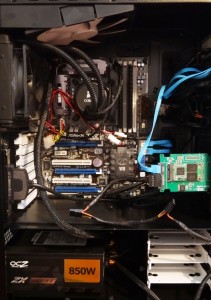TEST BENCH AND PROTOCOL
 Our analysis today will be conducted with our Asus Z77 Premium Test Bench. Clicking on any pictures or benchmarks will bring up a more easily viewable high resolution image.
Our analysis today will be conducted with our Asus Z77 Premium Test Bench. Clicking on any pictures or benchmarks will bring up a more easily viewable high resolution image.
In testing, our main objective is to obtain results as pure and as accurate as possible and we want to ensure that no anomalies slip through. Simply put, we want to provide you with the absolute best results the tested hardware can provide. Repetition in testing is standard and, if necessary, we may conduct specific tests in Windows 7 safe mode to ensure the OS has little to no influence on the end result.
In order to validate and confirm our findings, testing is supported by industry accepted benchmark programs. All results are displayed through capture of the actual benchmark for better understanding of the testing process by the reader.
We would like to thank ASUS (P8Z77-V Premium![]()
![]() ), Intel (Core i7-3770K
), Intel (Core i7-3770K![]() ), Crucial (Ballistix
), Crucial (Ballistix![]() ), Corsair (H100
), Corsair (H100![]() ) and Be Quiet (PSU/Fans) for supporting the build of our Z77 Premium Test Bench.
) and Be Quiet (PSU/Fans) for supporting the build of our Z77 Premium Test Bench.
BENCHMARK SOFTWARE
The software we will be using for today’s analysis is typical of many of our reviews and consists of ATTO Disk Benchmark, Crystal DiskMark, AS SSD, Anvil Storage Utilities and PCMark Vantage. We rely on these as they each have a way of supporting one another yet, at the same time, adding a new performance benchmark to the total picture. Much of the software is free and can be downloaded simply by clicking on the linked title.
UNDERSTANDING SANDISK NCACHE
In order to understand the mechanics of SanDisk’s new nCache, we have to step back a bit with a basic understanding of SSD characteristics, the first being the way in which SSDs are most commonly differentiated which is by speed. As unfortunate as it really is, consumers have little, if any understanding of SSD performance and are content to simply purchase an SSD with the fastest speed displayed on the package.
SSD speed is the time it takes to transfer a file from one spot to another and the speed is affected by different file types. Traditionally, easily compressible files such as applications or software can be transferred much faster than files that can’t be easily compressed, such as photographs, music or videos. Similarly, larger files enable the reaching of much higher transfer speeds than that of smaller files. In the end, the most difficult files to transfer are smaller (-1MB) files that are not very compressible. SanDisk had this in mind when they thought of nCache and understood that, traditionally, those small incompressible files were severely impairing the overall transfer speeds.
To combat this, SanDisk uses a small portion of their new 19nm 400Mb/s eX2 ABL MLC memory and creates an SLC style non-volatile cache. nCache gathers these small incompressible files together before flushing and consolidating them to the larger MLC section of the array, thus combating the slow write performance that we might normally see. SLC is much faster than MLC and it’s life span is 10 times that of MLC which theoretically provides a much lower write amplification, resulting in increased overall endurance.
In theory, this is an excellent idea and SanDisk’s representation of a total lifespan of 80TBW definitely shows that endurance is far superior than many SSDs. Whether or not an immediate performance benefit will be seen will become more evident throughout the report.
Crystal Disk Info provides some excellent information about the SSD itself to include its health, product information, power on information as well as the characteristics of the SSD. We can see that the SanDisk Ultra Plus is capable of TRIM as it is not greyed out, much like AAM.
 The SSD Review The Worlds Dedicated SSD Education and Review Resource |
The SSD Review The Worlds Dedicated SSD Education and Review Resource | 

So so performance, but fantastic price. Can’t wait to see what pricing on this SSD looks like in a couple months especially with SanDisk controlling the fab. Great review as always, Les!
Mine is a good example i guess 🙂
Purchased in 2013, heavy user, SanDisk Ultra Plus SSD is 4 years old now.
Run heavily modded Fallout 4 and Skyrim as well as Photoshop and 3DSmax.
SSD dashboard says 93% life left, thats 50+ years reliability @ heavy use.
Performance has decreased but working perfectly, no errors ever.